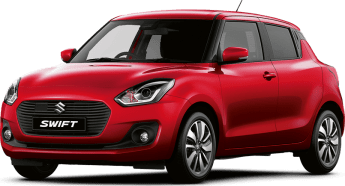Did you know Suzuki is one of the most profitable car companies in the world?
In fact, by some measures last year, the Japanese automaker overtook BMW as the most profitable automaker on the planet.
If that surprised you, you’re not alone. Sure, the brand produces some memorable models which have etched themselves on the Australian landscape over the decades, but they aren’t exactly technological wonders.
But nameplates like Swift, Vitara and Jimny have always been affordable, what-you-see-is-what-you-get type cars, and their simplicity gives Suzuki a unique ability to market them to developing economies like India and China as well as cashed-up first-world nations like Australia.
The Swift personifies that appeal, with its range spanning a wide berth from one of Australia’s cheapest hatchbacks, to the last surviving Japanese small performance hatch.
In an increasingly competitive segment though, does the Swift still have an edge? Let’s explore the range to find out.
Suzuki Swift 2019: GL Navigator
| Safety Rating |
|
|---|---|
| Engine Type | Inline 4, 1.2L |
| Fuel Type | Unleaded Petrol |
| Fuel Efficiency | 4.8L/100km (combined) |
| Seating | 5 |
| Price From | $14,300 - $18,810 |
Does it represent good value for the price? What features does it come with?
8 / 10
The Swift range now spans from the not-so-basic GL Navi manual ($16,990) up to the performance-oriented Sport auto ($27,490). Already that’s a more versatile price range than most competitors, but as you move up the range, the relative value changes dramatically.
To set the scene, competitor ranges include the Mazda2 ($15,320 - $23,140), Kia Rio ($16,990 - $23,090), Toyota Yaris ($15,390 - $22,670) and even the Skoda Fabia ($17,290 - $24,990).
From the get-go the Swift justifies its slightly higher price-point with decent equipment. The entry-level GL Navi manual has 16-inch alloy wheels, a 7.0-inch touchscreen with Apple CarPlay and Android Auto support, built-in navigation, a leather-trimmed steering wheel and a reversing camera.
.jpg)
You can add a Continuously Variable Transmission automatic for $1000 or step up to the GL Navi Safety Pack (auto only) for another $1000.
At this point I should pause to say that adding the Safety Pack the automatic Swift at $17,990 gives it the best active safety suite available on any hatch under $20,000. It is therefore our pick of the range. See the Safety section of this review for more on the Swift’s safety features.
You can read more about the best value hatchbacks under $20k here.
The next grade up is the Swift GLX Turbo ($22,990 – expensive for this segment). The GLX Turbo adds an improved engine, keyless entry, push-button start, climate control (instead of basic air-conditioning) LED headlights with auto-high beams and a sportier 16-inch alloy wheel design.
Stepping up to the Swift Sport ($25,490) comes at a significant cost but improves the engine out of sight. You can also have the Sport in either a six-speed manual or six-speed auto.
.jpg)
The Sport has all the refinements of the GLX Turbo but is overhauled with a bigger, punchier engine from the Vitara, front bucket seats, a more exotic bodykit and sporty 17-inch alloys.
The Sport is the last surviving Japanese performance hatch in this segment, and its only realistic competitor for the time being is the Kia Rio GT-Line ($23,090).
Is there anything interesting about its design?
7 / 10
The Swift is up there in the looks department, duking it out with the also good-looking Kia Rio and Mazda2.
It carries the cute styling points that have been built up over the last two generations of Swift.
The swoopy lines dash across the front and side of its bulbous frame, rounded out nicely by chunky light fittings at the rear and that signature convex windscreen. The integrated rear door handles help it maintain a slick profile from the rear three quarter.
.jpg)
There’s little to tell the GL Navi entry-level car and the GLX Turbo apart aside from the addition of LED daytime running lights and slightly different (but still 16-inch) alloys.
The Sport gains a more aggressive, flared bodykit with black and carbon highlights as well as a dual-exhaust, angry-looking dual-colour 17-inch alloy wheels and a unique grille.
.jpg)
All Swifts get a small, but hardly cramped cabin. The dash is dominated by a decently-sized 7.0-inch multimedia touchscreen across the range. The stock UX is hardly impressive, especially compared to segment leaders like the Kia Rio and Volkswagen Polo, but every variant supports Apple CarPlay and Android Auto.
Every variant also gets a leather-appointed steering wheel that’s slightly flat-bottomed, but the GL-Navi gets a dorky set of manual air-conditioning controls compared to the slicker climate control cluster in the GLX Turbo and Sport.
Embedded in the dash is a simple dot-matrix display which can show trip computer information in the GL Navi and GLX turbo, or a colour screen with some more interesting features like turbo pressure and power output displays on the Sport.
.jpg)
Interior materials are comprised mostly of cheap plastics. This approach is hardly unusual in the segment, but the Rio, Fabia, Polo and Mazda2 all feel less chintzy.
There’s also limited legroom, and, annoyingly, there’s nothing soft to rest your elbow on in the door in any Swift variant.

How practical is the space inside?
6 / 10
There’s no escaping that the Swift is smaller than some other cars in the segment. The bad news is this means the rear seat and boot are smaller than the competition.
The rear seats come across as more or less of an afterthought. I fit in, but only just in terms of leg and headroom, and unlike the rather good front seats, the rear lacks any kind of contouring for extra comfort.
.jpg)
Because of the roofline that tapers off toward the rear, headroom is also much better in the front seat. No Swift gets leather seats, but the front seats are spongey and come with a decent amount of side-bolstering which can hardly be said for other cars in the segment. The Sport gets chunkier bespoke seats with better support when cornering.
The boot maxes out at 242 litres with the seats up, and a surprisingly small 556 litres with the seats down, so it is hardly versatile if you spend lots of time lugging objects around.
.jpg)
Storage for front passengers is made up of two large bottle holders in the doors, two small bottle holders in the centre console and a shallow storage trench under the air-conditioning controls.
There is one 12-volt power output, an auxiliary input and a USB port hidden away above the trench.
Rear passengers get… not much. There are bottle holders in the doors and a small tray behind the handbrake for extra objects as well as a small pocket on the back of the front passenger seat.
Some competitors offer centre console boxes, bigger cupholders a second 12-volt output, and in terms of boot capacity the Honda Jazz, Hyundai Accent and Suzuki’s own Baleno are far better in this segment.
What are the key stats for the engine and transmission?
8 / 10
Across the Swift range there are three engines. The GL-Navi has a 1.2-litre non-turbo four-cylinder ‘DualJet’ offering 66kW/120Nm.
.jpg)
Stepping up to the GLX turbo introduces a 1.0-litre three-cylinder turbocharged engine producing 82kW/160Nm. That’s a significant boost in power over the base car, and peak torque arrives much earlier (1500rpm).
Finally, stepping up to the Sport adds a much spicier 1.4-litre four-cylinder engine normally tasked with propelling the heavier Vitara. The Sport can make use of 103kW/230Nm.
The GL-Navi can be had with either a six-speed manual or a CVT auto, the GLX Turbo can only be had with a six-speed traditional torque converter auto, while the Sport can either be had with a six-speed manual or torque converter.
The Swift’s range of engines and transmissions is fairly expansive but unlike some competitors in this segment, none of the options feel underpowered or outdated.
How much fuel does it consume?
7 / 10
Combined cycle fuel consumption for 1.2-litre variants is rated at 4.8L/100km. We produced a real-world figure of 6.8L/100km in the Swift GL Navi manual.
Moving up to the 1.0-litre turbo, fuel consumption is rated at 5.1L/100km. I scored 7.0L/100km in a real-world test of the GLX-Turbo and Peter Anderson scored 6.9L/100km.
The Sport has a combined fuel usage figure of 6.1L/100km against which I scored 8.0L/100km on my most recent week-long test. (good luck getting under that. It’s damned fun.)
What's it like to drive?
7 / 10
Thanks to some competent engine choices, all Swift variants are at least decent from behind the wheel.
Unlike entry-level versions of the Toyota Yaris and Kia Rio, the 1.2-litre engine in the GL-Navi feels up to speed. It’s not quick, but more than adequate for city driving duties. The availability of a manual is a plus for those who want to wring a bit more out of the little engine.
The 1.0-litre three cylinder in the GLX Turbo is a load of fun. It has the gruff snarl unique to three-cylinder engines, and the turbo kicks the boot in nice and early for a characterful drive experience.
The six-speed automatic, which is the sole transmission choice for the GLX, is better than the lackluster CVT in the GL Navi, and the addition of paddle shift adds temporary bursts of entertainment.
.jpg)
The Sport, true to its name, has far more power than it realistically needs, while not being as off-the-hook (or anywhere near as expensive) as properly ‘hot’ hatchbacks like the Renault Clio RS or Peugeot 208 GTi. For those interested, the Sport has a 0-100km/h time of 8.0 seconds.
It’s all the hot hatch most people will need, with its improved suspension qualities keeping it a little less skittish around corners and over bumps than the rest of the range.
All Swifts have solid, direct steering and standard MacPherson struts at the front with a torsion beam at the rear. Most of the time this set-up is reasonably comfortable around town, although the front is far softer than the rear which can sometimes result in the very light Swift becoming unsettled over poor surfaces. Road noise could definitely be better in any Swift.
Regular swift variants have turning circles of 4.8m whereas the Sport with its larger wheels has a turning circle of 5.1m.
Warranty & Safety Rating
What safety equipment is fitted? What safety rating?
8 / 10
All Swifts in the range carry maximum five-star ANCAP safety ratings as of June 2017.
However, unlike the entry-level Mazda2 Neo the base GL-Navi is void of active safety features.
Thankfully, there is a must-have safety pack which adds $1000 to the price. It’s worth every cent as it adds auto emergency braking (AEB), forward collision warning, lane keep assist with lane departure warning and active cruise control.
As mentioned earlier, that’s the most impressive active safety suite available in cars under $20k. Suddenly that extra $1000 on the GL Navi is worth every cent…
Unlike the base Mazda2, even the cheapest Swift has a reversing camera.
All Swifts have the expected stability controls, six airbags, dual ISOFIX child-seat mounting points on the outer rear seats and three top-tether points.
What does it cost to own? What warranty is offered?
6 / 10
Suzuki offers a five-year/140,000km warranty on the condition that you service on time at a Suzuki dealer.
.jpg)
Otherwise the warranty is limited to three-years/unlimited km. Most rivals now offer at least non-conditional five-year, unlimited kilometer promises.
To really twist the knife, Suzuki requires that you service the Swift at inconvenient six-month intervals (or 10,000km, whichever comes first).
Servicing isn’t particularly cheap either. For the life of the five-year warranty, Turbo variants cost an average of $490.40 to service a year, while the 1.2-litre non-turbo is hardly cheaper at an average of $476.40 per year. Expensive for a ‘cheap’ car.
Verdict
Suzuki offers a diverse range of Swifts, for the budget buyer who doesn’t mind a bare-bones offering , as well as those looking for a bit more out of their small hatch.
The GL Navi makes a great city car which is good to drive but compromised on storage, the GLX Turbo makes for an even better package, but is priced to make it a choice-over-value proposition, and the Sport is a uniquely positioned alternative to other hot hatches that shouldn’t be overlooked.
The impressive tech and safety features and decent driving characteristics of the GL Navi with the Safety Pack makes it our pick of the range.
What’s more important to you when choosing a small hatch, is it practicality, safety or performance? Tell us what you think in the comments below.
Pricing Guides

Range and Specs
| Vehicle | Specs | Price* |
|---|---|---|
| GL Navi | 1.2L, Unleaded Petrol, SPEED CONTINUOUS VARIABLE | $12,210 - $16,280 |
| GLX (qld) | 1.0L, Unleaded Petrol, 6 SPEED AUTOMATIC | $15,730 - $20,130 |
| GLX Turbo | 1.0L, Unleaded Petrol, 6 SPEED AUTOMATIC | $16,500 - $21,120 |


.jpg)


.jpg)
.jpg)
.jpg)








































.jpg)
.jpg)

.jpg)



.jpg)
Comments